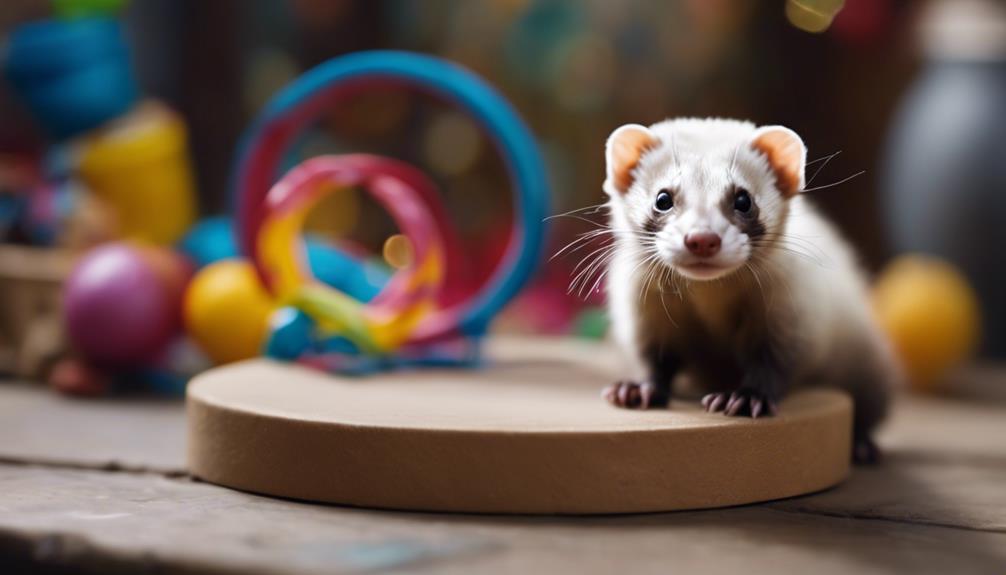How to Train Your Ferret to Perform Tricks

How to Train Your Ferret to Perform Tricks:
Patience, consistency, and understanding your pet’s behavior are key.
Unlock a world of fun and connection by tailoring training to suit their unique characteristics.
Choosing the Right Training Rewards
Are you ready to teach your ferret some cool tricks? Picking the right treats is super important for making sure your furry friend learns well! Let’s dive into the world of training rewards for your ferret:
What Treats Does Your Ferret Like?
- Just like us, ferrets have their favorite foods. Some may go crazy for meaty treats, while others might prefer fruits or veggies. It’s essential to know what your ferret loves to keep them motivated during training.
Why Mix It Up?
- Variety is the spice of life, even for ferrets! Switching up the types of treats you use can keep your ferret interested and excited. Different tastes and textures can also keep them engaged and eager to learn new tricks.
Keep It Small and Tasty!
- When choosing treats, go for small bites that your ferret can gobble up quickly. This way, you can keep the training flow going smoothly without long breaks for snack time.
Setting Up a Training Routine

Getting Your Ferret Ready to Learn Tricks
Hey there, ferret enthusiasts! Are you ready to teach your furry friend some cool tricks and behaviors? Let’s dive into how you can set up a fun and effective training routine for your ferret.
Bonding Time Is Key
- Want to strengthen your bond with your ferret while training? Try cuddling, grooming, or playing together before starting the training session. It will make the experience more enjoyable for both of you!
Choosing the Right Time
- Ferrets are most active in the early morning and evening, so pick these times for training when your ferret is alert and focused.
- Consistency is key! Short daily training sessions work better than long ones now and then.
Setting the Scene
- Find a quiet, well-lit spot with no distractions for your training sessions. This will help your ferret stay focused and ready to learn.
Starting With Basic Commands

Starting with Basic Commands for Your Ferret
Hey there, ferret enthusiasts! Are you ready to teach your fuzzy friend some cool tricks? Let’s start with the basics to lay a strong foundation for their training. Here’s how you can get started:
- Clicker Training Basics:
- Clicker training is a fantastic way to teach your ferret new commands.
- Use a clicker to mark the behavior you want to see and then reward them with a treat.
- Start with simple commands like ‘sit’ or ‘come’ and gradually move on to more advanced tricks as they learn.
- Bonding Exercises:
- Spending quality time with your ferret is essential for building a strong bond.
- Engage in activities that promote trust and strengthen your relationship.
- Socialization tips can help your ferret feel comfortable in different environments and around new people.
- Enhancing Confidence:
- Building your ferret’s confidence is key to their learning process.
- By socializing them and exposing them to new experiences, you can boost their confidence and willingness to learn new tricks.
Using Positive Reinforcement Techniques

Positive reinforcement techniques are essential for training ferrets effectively.
By rewarding good behavior with treats and consistent praise, ferrets learn to associate performing tricks with positive outcomes.
Patience and persistence are key when using these techniques to ensure your ferret grasps the desired behaviors.
Rewarding Good Behavior
Want to train your ferret to do cool tricks? Here’s how to reward their good behavior!
Hey there, ferret enthusiasts! Training your ferret can be a fun and rewarding experience, especially when you use rewards to reinforce good behavior. Let’s dive into some key strategies to make your ferret training sessions a success:
- Yummy Treats: Choose treats that your ferret absolutely loves to keep them motivated and excited to learn.
- Quick Rewards: Give treats right after your ferret does the trick correctly to help them understand what behavior you’re rewarding.
- Be Consistent: Make sure to reward the same behavior every time so your ferret doesn’t get confused about what they’re being praised for.
- Love and Affection: Mix treats with kind words and gentle pets to build a strong bond with your ferret while training.
Consistent Praise and Treats
Are you ready to make your ferret training sessions more fun and effective? Let’s dive into the world of consistent praise and treats to help your furry friend learn and grow!
Why is consistent praise and treats important in ferret training?
- Ferrets love positive reinforcement, so praising and treating them consistently helps reinforce good behavior.
- This method creates a positive association with desired actions, making training more enjoyable for your ferret.
How to use consistent praise and treats in training:
- When your ferret does a trick or shows good behavior, praise them right away with a happy voice.
- Offer a small treat as a reward to show them they did a great job.
- This helps your ferret understand which behaviors lead to rewards, improving their training progress.
Patience and Persistence
Unlocking Your Ferret’s Potential: Training Tips for Success
Hey there, ferret enthusiasts! Are you ready to dive into the world of training your furry friend? Let’s explore some key tips to help you on this exciting journey:
- What makes your ferret tick?
Discover what gets your ferret excited, whether it’s tasty treats, fun toys, or playtime. Use these as rewards to motivate and engage your ferret during training sessions.
- Take it step by step:
Break down tricks into easy-to-follow stages. Start with simple tasks and gradually increase the difficulty as your ferret becomes more skilled.
- Consistency is key:
Keep your training sessions consistent and use the same cues each time. This helps your ferret understand what’s expected and reinforces their learning.
- Celebrate every victory:
Even small achievements deserve a celebration! Acknowledge and reward your ferret for their progress to keep them motivated and eager to learn more.
Implementing Clicker Training

Unlock the secrets of training your ferret with a cool tool called clicker training! This method uses a special sound to help your fuzzy friend learn new tricks and behaviors. Let’s dive into the world of clicker training and discover how it can benefit you and your furry pal.
What’s clicker training for ferrets?
- Clicker training pairs a distinct sound (the clicker) with a desired behavior to help your ferret learn.
- It allows for precise communication, making it easier for your ferret to understand when they’ve done something right.
- By instantly reinforcing positive actions, clicker training speeds up the learning process.
How to get started with clicker training:
- Begin by associating the clicker sound with a yummy treat to create a positive connection.
- Once your ferret understands this link, you can teach them fun tricks like rolling over or fetching using the clicker as a signal.
- Keep training sessions short and enjoyable to maintain your ferret’s interest and motivation.
Tips for successful clicker training:
- Be consistent in using the clicker and treats to reinforce desired behaviors.
- Remember that your ferret might become dependent on these cues for performing tricks.
- With patience and regular practice, clicker training can help you teach your ferret impressive and entertaining tricks.
Ready to embark on a training adventure with your ferret? Clicker training could be the key to unlocking their full potential and creating a strong bond between you and your playful pet!
Overcoming Training Challenges

When training a ferret to perform tricks, patience is key as these animals can be easily distracted.
Consistent practice routines that incorporate short, frequent training sessions will help reinforce the desired behaviors.
Patience in Training
Mastering Ferret Training: Tips for Success!
Hey there, ferret enthusiasts! Ready to train your furry friend like a pro? Let’s dive into some handy tips to make the training process smooth and fun.
Consistent Consistency: Stick to a regular training routine to help your ferret learn and remember commands better.
Short and Sweet Sessions: Keep training sessions brief and engaging to hold your ferret’s attention and prevent boredom.
Pawsitive Reinforcement: Use yummy treats and lots of praise to encourage your ferret and reinforce good behaviors.
Flexibility is Key: Stay open to adjusting your training methods based on how your ferret reacts. Being adaptable makes learning more enjoyable for both of you!
Ready to become a ferret training pro? With these tips, you’ll be well on your way to bonding and teaching your ferret new tricks in no time. Happy training!
Consistent Practice Routine
Are you ready to teach your ferret some cool tricks? One key to success is establishing a consistent practice routine. Let’s dive into how you can make training fun and effective for your furry friend!
Why is Consistency Important?
- Regular, structured training sessions help reinforce learning.
- Consistent practice builds upon previous lessons.
- Stability in training environment aids in grasping and retaining tricks.
How to Create a Routine:
- Set a schedule: Pick specific times for training sessions.
- Stick to it: Be reliable and follow through with your plans.
- Keep it predictable: Create a consistent training environment.
Benefits of Regular Practice:
- Strengthens the bond between you and your ferret.
- Enhances communication and trust.
- Smooths out the learning process for your furry friend.
Showcasing Your Ferret’s Tricks

Does your ferret have some cool tricks up its sleeve? Want to show off its talents and impress your friends and family? Here are some simple tips to help you create a fun and engaging showcase for your ferret’s tricks:
- Setting the Stage: Find a quiet, well-lit spot in your home where your ferret can perform its tricks without distractions. Think of it as creating a mini theater just for your furry friend!
- Getting the Audience Involved: Invite your loved ones to watch your ferret’s tricks and interact with them during the show. Who doesn’t love a little audience participation?
- Spicing Up the Routine: Keep things exciting by adding new twists to the tricks your ferret already knows. How about teaching them to do a spin or jump through a hoop? The possibilities are endless!
- Dress to Impress: To add a touch of pizzazz, consider dressing up your ferret in cute costumes that match the tricks they’re performing. It’s sure to make the show even more entertaining!
With these simple tips, you can create a fun and engaging showcase for your ferret’s tricks that will leave your audience in awe. Get ready to be the star of your own furry little circus!
Frequently Asked Questions
Can Ferrets Be Trained to Do Tricks Similar to Dogs or Other Animals?
Ferrets possess intelligence and can be trained to perform tricks, albeit with limitations compared to dogs or other animals. Their motivation is key, relying on rewards for effective training. Patience and consistency are crucial for success.
How Long Does It Typically Take to Train a Ferret to Perform a New Trick?
Training consistency is crucial for ferret success. Their motivation and the complexity of the trick impact the time commitment. Short, simple tricks may take a few days, while more complex ones could require a few weeks.
Are There Any Specific Tricks That Are Easier or More Difficult for Ferrets to Learn?
Some tricks might be easier for ferrets to learn due to their natural abilities and preferences. Training techniques play a significant role in trick difficulty. Understanding these factors can help improve the effectiveness of ferret training sessions.
Can Ferrets Be Trained to Respond to Verbal Commands as Well as Hand Signals?
Like a well-choreographed dance, ferrets can be taught to respond to both verbal commands and hand signals. Training techniques should consider ferret intelligence and behavioral challenges to effectively communicate and engage with these curious creatures.
Are There Any Safety Precautions to Keep in Mind When Training a Ferret to Perform Tricks?
When training a ferret to perform tricks, it’s essential to prioritize safety. Precautions include using proper ferret training equipment and following safety tips. This ensures a positive training experience and minimizes any potential risks to the ferret.











